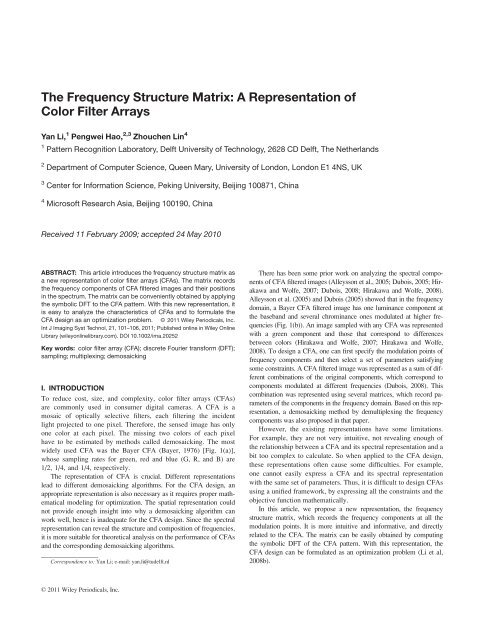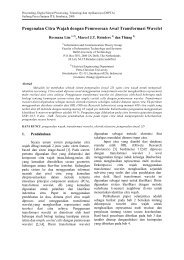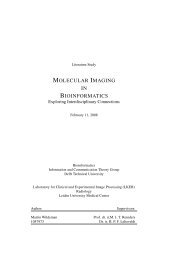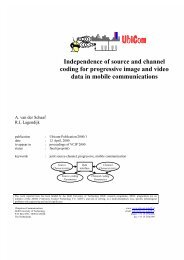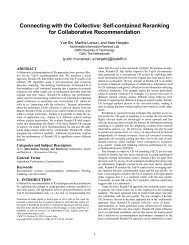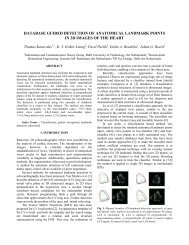The frequency structure matrix: A representation of color filter arrays
The frequency structure matrix: A representation of color filter arrays
The frequency structure matrix: A representation of color filter arrays
Create successful ePaper yourself
Turn your PDF publications into a flip-book with our unique Google optimized e-Paper software.
<strong>The</strong> Frequency Structure Matrix: A Representation <strong>of</strong><br />
Color Filter Arrays<br />
Yan Li, 1 Pengwei Hao, 2,3 Zhouchen Lin 4<br />
1 Pattern Recognition Laboratory, Delft University <strong>of</strong> Technology, 2628 CD Delft, <strong>The</strong> Netherlands<br />
2 Department <strong>of</strong> Computer Science, Queen Mary, University <strong>of</strong> London, London E1 4NS, UK<br />
3 Center for Information Science, Peking University, Beijing 100871, China<br />
4 Micros<strong>of</strong>t Research Asia, Beijing 100190, China<br />
Received 11 February 2009; accepted 24 May 2010<br />
ABSTRACT: This article introduces the <strong>frequency</strong> <strong>structure</strong> <strong>matrix</strong> as<br />
a new <strong>representation</strong> <strong>of</strong> <strong>color</strong> <strong>filter</strong> <strong>arrays</strong> (CFAs). <strong>The</strong> <strong>matrix</strong> records<br />
the <strong>frequency</strong> components <strong>of</strong> CFA <strong>filter</strong>ed images and their positions<br />
in the spectrum. <strong>The</strong> <strong>matrix</strong> can be conveniently obtained by applying<br />
the symbolic DFT to the CFA pattern. With this new <strong>representation</strong>, it<br />
is easy to analyze the characteristics <strong>of</strong> CFAs and to formulate the<br />
CFA design as an optimization problem. VC 2011 Wiley Periodicals, Inc.<br />
Int J Imaging Syst Technol, 21, 101–106, 2011; Published online in Wiley Online<br />
Library (wileyonlinelibrary.com). DOI 10.1002/ima.20252<br />
Key words: <strong>color</strong> <strong>filter</strong> array (CFA); discrete Fourier transform (DFT);<br />
sampling; multiplexing; demosaicking<br />
I. INTRODUCTION<br />
To reduce cost, size, and complexity, <strong>color</strong> <strong>filter</strong> <strong>arrays</strong> (CFAs)<br />
are commonly used in consumer digital cameras. A CFA is a<br />
mosaic <strong>of</strong> optically selective <strong>filter</strong>s, each <strong>filter</strong>ing the incident<br />
light projected to one pixel. <strong>The</strong>refore, the sensed image has only<br />
one <strong>color</strong> at each pixel. <strong>The</strong> missing two <strong>color</strong>s <strong>of</strong> each pixel<br />
have to be estimated by methods called demosaicking. <strong>The</strong> most<br />
widely used CFA was the Bayer CFA (Bayer, 1976) [Fig. 1(a)],<br />
whose sampling rates for green, red and blue (G, R, and B) are<br />
1/2, 1/4, and 1/4, respectively.<br />
<strong>The</strong> <strong>representation</strong> <strong>of</strong> CFA is crucial. Different <strong>representation</strong>s<br />
lead to different demosaicking algorithms. For the CFA design, an<br />
appropriate <strong>representation</strong> is also necessary as it requires proper mathematical<br />
modeling for optimization. <strong>The</strong> spatial <strong>representation</strong> could<br />
not provide enough insight into why a demosaicking algorithm can<br />
work well, hence is inadequate for the CFA design. Since the spectral<br />
<strong>representation</strong> can reveal the <strong>structure</strong> and composition <strong>of</strong> frequencies,<br />
it is more suitable for theoretical analysis on the performance <strong>of</strong> CFAs<br />
and the corresponding demosaicking algorithms.<br />
Correspondence to: Yan Li; e-mail: yan.li@tudelft.nl<br />
<strong>The</strong>re has been some prior work on analyzing the spectral components<br />
<strong>of</strong> CFA <strong>filter</strong>ed images (Alleysson et al., 2005; Dubois, 2005; Hirakawa<br />
and Wolfe, 2007; Dubois, 2008; Hirakawa and Wolfe, 2008).<br />
Alleysson et al. (2005) and Dubois (2005) showed that in the <strong>frequency</strong><br />
domain, a Bayer CFA <strong>filter</strong>ed image has one luminance component at<br />
the baseband and several chrominance ones modulated at higher frequencies<br />
(Fig. 1(b)). An image sampled with any CFA was represented<br />
with a green component and those that correspond to differences<br />
between <strong>color</strong>s (Hirakawa and Wolfe, 2007; Hirakawa and Wolfe,<br />
2008). To design a CFA, one can first specify the modulation points <strong>of</strong><br />
<strong>frequency</strong> components and then select a set <strong>of</strong> parameters satisfying<br />
some constraints. A CFA <strong>filter</strong>ed image was represented as a sum <strong>of</strong> different<br />
combinations <strong>of</strong> the original components, which correspond to<br />
components modulated at different frequencies (Dubois, 2008). This<br />
combination was represented using several matrices, which record parameters<br />
<strong>of</strong> the components in the <strong>frequency</strong> domain. Based on this <strong>representation</strong>,<br />
a demosaicking method by demultiplexing the <strong>frequency</strong><br />
components was also proposed in that paper.<br />
However, the existing <strong>representation</strong>s have some limitations.<br />
For example, they are not very intuitive, not revealing enough <strong>of</strong><br />
the relationship between a CFA and its spectral <strong>representation</strong> and a<br />
bit too complex to calculate. So when applied to the CFA design,<br />
these <strong>representation</strong>s <strong>of</strong>ten cause some difficulties. For example,<br />
one cannot easily express a CFA and its spectral <strong>representation</strong><br />
with the same set <strong>of</strong> parameters. Thus, it is difficult to design CFAs<br />
using a unified framework, by expressing all the constraints and the<br />
objective function mathematically.<br />
In this article, we propose a new <strong>representation</strong>, the <strong>frequency</strong><br />
<strong>structure</strong> <strong>matrix</strong>, which records the <strong>frequency</strong> components at all the<br />
modulation points. It is more intuitive and informative, and directly<br />
related to the CFA. <strong>The</strong> <strong>matrix</strong> can be easily obtained by computing<br />
the symbolic DFT <strong>of</strong> the CFA pattern. With this <strong>representation</strong>, the<br />
CFA design can be formulated as an optimization problem (Li et al,<br />
2008b).<br />
' 2011 Wiley Periodicals, Inc.
Figure 1. Bayer CFA pattern (Bayes, 1976) and the spectrum <strong>of</strong> the ‘window’ image <strong>filter</strong>ed with it. (c)–(f) show each component in the spectrum<br />
(b). (c) (F (R) 1 2F (G) 1 F (B) )/4 at <strong>frequency</strong> point (0,0), (d) (2F (R) 1 F (B) )/4 modulated at (0.5,0), (e) (F (R) 2F (B) )/4 at (0,0.5), and (f) (2F (R) 1 2F (G)<br />
2F (B) )/4 at (0.5,0.5). <strong>The</strong> ‘window’ is a commonly used test image from the Kodak dataset (Alleysson et al., 2005). [Color figure can be viewed in<br />
the online issue, which is available at wileyonlinelibrary.com.]<br />
II. THE FREQUENCY STRUCTURE MATRIX<br />
Figure 1b shows the spectrum <strong>of</strong> the image ‘‘window’’ <strong>filter</strong>ed with<br />
the Bayer CFA. As shown by Alleysson et al., (2005) and Dubois,<br />
(2005), it contains several <strong>frequency</strong> components: (F (R) 1 2F (G) 1<br />
F (B) )/4 at <strong>frequency</strong> point (0,0), (2F (R) 1 F (B) )/4 modulated at (0.5,<br />
0), (F (R) 2 F (B) )/4 at (0,0.5), and (2F (R) 1 2F (G) 2 F (B) )/4 at (0.5,<br />
0.5), where F (R) , F (G) , and F (B) denote the DFT spectra <strong>of</strong> the original<br />
image <strong>of</strong> primary <strong>color</strong>s R, G, and B, respectively, and one period<br />
in the <strong>frequency</strong> domain is a square [0,1) 2 . It is also shown that<br />
images <strong>filter</strong>ed with any CFA have similar spectra, consisting <strong>of</strong><br />
several components modulated at different <strong>frequency</strong> points (Hirakawa<br />
and Wolfe, 2007; Dubois, 2008; Hirakawa and Wolfe, 2008).<br />
Inspired by the observed patterns <strong>of</strong> the spectra <strong>of</strong> CFA <strong>filter</strong>ed<br />
images, we propose to represent the spectra by faithfully recording the<br />
<strong>frequency</strong> components: their <strong>frequency</strong> details and their positions.<br />
Such information can naturally be arranged in a <strong>matrix</strong> form. <strong>The</strong>refore,<br />
we call it the <strong>frequency</strong> <strong>structure</strong> <strong>matrix</strong>. For example, we may<br />
represent the spectrum <strong>of</strong> an image <strong>filter</strong>ed with the Bayer CFA as:<br />
S Bayer ¼ 1 <br />
F ðRÞ þ 2F ðGÞ þ F ðBÞ F ðRÞ þ F ðBÞ<br />
4 F ðRÞ F ðBÞ F ðRÞ þ 2F ðGÞ F ðBÞ<br />
<br />
:<br />
(Note that by convention the spectra <strong>of</strong> images are displayed with<br />
(0,0) being at the center, while in the <strong>frequency</strong> <strong>structure</strong> <strong>matrix</strong>,<br />
(0,0) is at the top-left corner <strong>of</strong> the <strong>matrix</strong>. <strong>The</strong> readers should circularly<br />
shift either <strong>of</strong> them in order to match them.) One can see<br />
that all the information <strong>of</strong> the spectra that is <strong>of</strong> interest to him/her<br />
can be found in S Bayer .<br />
In the following, we present the formal definition <strong>of</strong> the <strong>frequency</strong><br />
<strong>structure</strong> <strong>matrix</strong>. We also prove that the <strong>frequency</strong> <strong>structure</strong><br />
<strong>matrix</strong> can be easily calculated by applying the symbolic DFT to<br />
the CFA pattern. For brevity, sometimes we may write ‘‘<strong>frequency</strong><br />
<strong>structure</strong>’’ instead <strong>of</strong> ‘‘<strong>frequency</strong> <strong>structure</strong> <strong>matrix</strong>.’’<br />
III. FROM SPECTRA TO FREQUENCY STRUCTURE<br />
To obtain the <strong>frequency</strong>-domain <strong>representation</strong>, a CFA <strong>filter</strong>ed image<br />
is first represented in the spatial domain by decomposing the image<br />
and the CFA pattern into three channels, corresponding to three primary<br />
<strong>color</strong>s, respectively. <strong>The</strong>n, the DFT <strong>of</strong> the CFA <strong>filter</strong>ed image is<br />
computed using the convolution theory. Once the expression <strong>of</strong> the<br />
spectrum is available, we can identify its <strong>frequency</strong> components and<br />
their corresponding positions in the <strong>frequency</strong> domain. <strong>The</strong>n, we can<br />
arrange these components into a <strong>matrix</strong> form, according to their positions,<br />
and obtain the <strong>frequency</strong> <strong>structure</strong> <strong>matrix</strong>.<br />
102 Vol. 21, 101–106 (2011)
Figure 2. <strong>The</strong> Bean CFA pattern (Bean, 2003) and the spectra <strong>of</strong> the ‘window’ image <strong>filter</strong>ed with it. (a) <strong>The</strong> Bean CFA pattern, (b) the spectrum<br />
F (B)<br />
Bean <strong>of</strong> the blue channel <strong>of</strong> the Bean CFA <strong>filter</strong>ed image, represented by the <strong>frequency</strong> <strong>structure</strong> (8), (c) the spectrum F Bean <strong>of</strong> the Bean CFA <strong>filter</strong>ed<br />
image, represented by the <strong>frequency</strong> <strong>structure</strong> (11) or (13). [Color figure can be viewed in the online issue, which is available at<br />
wileyonlinelibrary.com.]<br />
A. Spectra <strong>of</strong> CFA Filtered Images. A CFA h CFA (x,y) is usually<br />
a periodic tiling <strong>of</strong> a much smaller array called the CFA pattern<br />
h p (x,y). Using the well-established tri-primary <strong>color</strong> theory, a CFA<br />
pattern can be decomposed into three primary CFA patterns<br />
h ðCÞ<br />
p<br />
ðx; yÞ, each accounting for one primary <strong>color</strong> C (Alleysson et al.,<br />
2005; Hirakawa and Wolfe, 2007; Dubois, 2008). <strong>The</strong>n, symbolically<br />
we can write:<br />
h p ¼ X C<br />
h ðCÞ<br />
p C: ð1Þ<br />
To ensure the same dynamic range <strong>of</strong> the sensed image at all pixels,<br />
the sum <strong>of</strong> all primary CFA patterns should be an all-one <strong>matrix</strong><br />
X<br />
h ðCÞ<br />
p ðx; yÞ ¼1; 8x; y: ð2Þ<br />
C<br />
For example, for the Bean CFA pattern h Bean 5 [C M;BY] (Fig. 2a),<br />
the primary CFA patterns <strong>of</strong> <strong>color</strong>s R, G, and B are respectively:<br />
2<br />
0 1 3 2<br />
1<br />
3<br />
Bean ¼ 6 2 7<br />
4<br />
0 1 5; h ðGÞ<br />
Bean ¼ 6 2 0 7<br />
4<br />
0 1 2<br />
2<br />
h ðRÞ<br />
5;h ðBÞ<br />
2<br />
1<br />
3<br />
1<br />
Bean ¼ 4 2 2 5;<br />
1 0<br />
as M 5 (R 1 B)/2, Y 5 (R 1 G)/2 and C 5 (G 1 B)/2.<br />
Let f(x,y) be the full <strong>color</strong> image <strong>of</strong> size (N x ,N y ) and the CFA<br />
pattern h p (x,y) be <strong>of</strong> size (n x ,n y ). <strong>The</strong>n, the CFA <strong>filter</strong>ed image is:<br />
f CFA ðx; yÞ ¼ X C<br />
f ðCÞ ðx; yÞh ðCÞ<br />
CFAðx; yÞ; ð4Þ<br />
where f ðCÞ ðx; yÞ is the <strong>color</strong> C component <strong>of</strong> f and h ðCÞ<br />
CFAðx; yÞ is the<br />
corresponding CFA <strong>of</strong> <strong>color</strong> C defined as the periodic replica <strong>of</strong> the<br />
primary CFA pattern h ðCÞ<br />
p ðx; yÞ:<br />
h ðCÞ<br />
CFAðx; yÞ ¼hðCÞ p ðx mod n x; y mod n y Þ:<br />
H<br />
Without loss <strong>of</strong> generality, we assume that N x and N y are multiples<br />
<strong>of</strong> n x and n y , respectively. We first compute the spectrum <strong>of</strong><br />
ðx; yÞ (Li et al., 2008):<br />
h ðCÞ<br />
CFA<br />
ðCÞ<br />
CFA ðx x; x y Þ¼DFT½h ðCÞ<br />
CFAðx; yÞŠ<br />
where H ðCÞ<br />
p<br />
¼ 1<br />
Nx X 1<br />
N x N y x¼0<br />
(<br />
¼<br />
XN y 1<br />
y¼0<br />
h ðCÞ<br />
i2pðxxxþyxyÞ<br />
CFAðx; yÞe<br />
HðCÞ p ðx x ; x y Þ; if n x x x 2 Z and n y x y 2 Z;<br />
0; otherwise;<br />
ðx x ; x y Þ is the DFT <strong>of</strong> the primary CFA pattern<br />
h ðCÞ<br />
p ðx; yÞ. Note that here (x x ,x y ) takes discrete values in the square<br />
[0,1) 2 (at a stepsize <strong>of</strong> (1/N x ,1/N y ) for H ðCÞ<br />
CFA and (1/n x,1/n y ) for Hp ðCÞ ,<br />
respectively) instead <strong>of</strong> discrete indices <strong>of</strong> the signals because we have<br />
found that it is more convenient to normalize the frequencies. <strong>The</strong> above<br />
equality shows that the spectrum <strong>of</strong> a CFA is a sampling <strong>of</strong> the spectrum<br />
<strong>of</strong> its CFA pattern at frequencies (k x /n x ,k y /n y ), where (k x ,k y ) [ Z 2 .<br />
As multiplication in the spatial domain corresponds to the circular<br />
convolution in the <strong>frequency</strong> domain, the DFT <strong>of</strong> f ðCÞ<br />
CFA can be<br />
found to be (Li et al., 2008):<br />
F ðCÞ<br />
CFA ðx x; x y Þ¼DFT½f ðCÞ ðx; yÞh ðCÞ<br />
CFA<br />
<br />
¼ Xnx 1 Xn y 1<br />
k x¼0 k y¼0<br />
H ðCÞ<br />
p<br />
k x<br />
n x<br />
; k y<br />
n y<br />
ðx; yÞŠ<br />
<br />
F ðCÞ k x<br />
x x ; x y<br />
n x<br />
k y<br />
n y<br />
ð5Þ<br />
<br />
: ð6Þ<br />
<br />
<br />
where F ðCÞ k<br />
x x k<br />
x n x<br />
; x<br />
y<br />
y n y<br />
has been circularly shifted. This<br />
implies that in the <strong>frequency</strong> domain the spectrum F ðCÞ<br />
CFA<br />
is a multiplexing<br />
<strong>of</strong> n x n y <strong>frequency</strong> components centered at (k x /n x ,k y /n y ),k x 5<br />
0,1,...,n x 2 1;k y 5 0,1,...,n y 2 1, and each component is the original<br />
spectrum F ðCÞ weighted by Hp<br />
ðCÞ ðk x =n x ; k y =n y Þ, the spectral value <strong>of</strong><br />
the CFA pattern at the corresponding <strong>frequency</strong>. Figure 2b shows<br />
an example <strong>of</strong> the spectrum.<br />
B. <strong>The</strong> Frequency Structure. As exemplified in Section II and<br />
shown by Li et al. (2008), it will be more intuitive and useful to<br />
arrange the identified <strong>frequency</strong> components in a <strong>matrix</strong> form.<br />
<strong>The</strong>refore, we use a <strong>matrix</strong> S ðCÞ<br />
CFA<br />
Eq. (6):<br />
to represent the spectrum FðCÞ CFA in<br />
Vol. 21, 101–106 (2011) 103
Figure 3. Some existing CFA patterns. <strong>The</strong> second row are the spectra <strong>of</strong> image ‘window’ sampled with the corresponding CFAs in the first<br />
row. (a) Yamanaka (1977), (b) Diagonal Stripe (Lukac and Plataniotis, 2005), (c) Dillon (1977). [Color figure can be viewed in the online issue, which<br />
is available at wileyonlinelibrary.com.]<br />
S ðCÞ<br />
CFA ¼<br />
<br />
HðCÞ p<br />
<br />
k x<br />
; k <br />
y<br />
n x n y<br />
<br />
F ðCÞ ðxÞ<br />
kx ¼ 0; 1; :::; nx 1;<br />
ky ¼ 0; 1; :::; ny 1: ð7Þ<br />
<strong>The</strong> entries <strong>of</strong> the <strong>matrix</strong> S CFA are actually:<br />
S CFA ðk x ; k y Þ¼ X C<br />
H ðCÞ<br />
p<br />
<br />
k x<br />
; k <br />
y<br />
n x n y<br />
F ðCÞ ðx x ; x y Þ;<br />
ð10Þ<br />
It records all the information about the <strong>frequency</strong> components <strong>of</strong><br />
F ðCÞ<br />
CFA : the (k x, k y )-th entry S ðCÞ<br />
CFA ðk x; k y Þ is the <strong>frequency</strong> component<br />
centered at (k x /n x , k y /n y ). We call this <strong>matrix</strong> the <strong>frequency</strong> <strong>structure</strong><br />
<strong>of</strong> the primary CFA h ðCÞ<br />
CFA<br />
<strong>of</strong> <strong>color</strong> C.<br />
For example, for the primary Bean CFA pattern <strong>of</strong> <strong>color</strong> blue<br />
(B)<br />
[Eq. (3)], its DFT is DFT[h Bean ] 5 [1/2 1/4; 0 2 1/4] and thus its<br />
<strong>frequency</strong> <strong>structure</strong> is<br />
2<br />
3<br />
1 1<br />
S ðBÞ<br />
Bean ¼ 6 2 FðBÞ 4 FðBÞ 7<br />
4<br />
1<br />
5; ð8Þ<br />
0<br />
4 FðBÞ<br />
where F (B) (B)<br />
denotes the spectrum <strong>of</strong> the blue channel <strong>of</strong> f. S Bean<br />
(B)<br />
shows that F Bean has three nonzero spectra: one is F (B) /2, at the<br />
baseband, one is F (B) /4, modulated at <strong>frequency</strong> (1/2, 0) and another<br />
is 2F (B) (B)<br />
/4, at (1/2, 1/2). Figure 2b shows the spectrum F Bean .<br />
Now we are equipped to define the <strong>frequency</strong> <strong>structure</strong> <strong>matrix</strong> <strong>of</strong><br />
a CFA pattern. According to (4), we may define the <strong>frequency</strong><br />
<strong>structure</strong> <strong>of</strong> a CFA pattern as the following <strong>matrix</strong>:<br />
S CFA ¼ P C<br />
S ðCÞ<br />
CFA :<br />
ð9Þ<br />
k x 5 0, 1,...,n x 2 1; k y 5 0, 1,..., n y 21. <strong>The</strong> entry S CFA (k x , k y )<br />
denotes the <strong>frequency</strong> component <strong>of</strong> the spectrum F CFA centered<br />
(or modulated) at <strong>frequency</strong> (k x /n x , k y /n y ). Thus the spectrum <strong>of</strong><br />
F CFA is a multiplexing <strong>of</strong> n x . n y components S CFA (k x , k y ) centered<br />
at grid points (k x /n x , k y /n y )(k x 5 0, 1,...,n x 2 1; k y 5 0,1,...,n y 2 1).<br />
For this reason, we refer to the entries (10) in S CFA as the multiplex<br />
components, which are sums <strong>of</strong> the spectra F ðCÞ weighted by Hp ðCÞ .<br />
For example, the <strong>frequency</strong> <strong>structure</strong> <strong>of</strong> the Bean CFA pattern,<br />
as the sum <strong>of</strong> S ðCÞ<br />
Bean ; C¼R; G; B, is:<br />
S Bean ¼<br />
2<br />
3<br />
X 1<br />
S ðCÞ<br />
Bean ¼ 4 4 FðRÞ 1 4 FðRÞ 5<br />
0 0<br />
2<br />
1<br />
3 2<br />
þ<br />
4 FðGÞ 0 1 1<br />
3<br />
6<br />
7<br />
4<br />
5 þ 4 2 FðBÞ 4 FðBÞ<br />
5<br />
1<br />
0<br />
4 FðGÞ 0 1<br />
4 FðBÞ<br />
" #<br />
¼ 1 F ðRÞ þ F ðGÞ þ 2F ðBÞ F ðRÞ þ F ðBÞ<br />
4 0 F ðGÞ F ðBÞ<br />
C¼R;G;B<br />
ð11Þ<br />
104 Vol. 21, 101–106 (2011)
This shows that the spectrum F CFA <strong>of</strong> the Bean CFA <strong>filter</strong>ed image<br />
has three nonzero multiplex components: (F (R) 1 F (G) 1 2F (B) )/4 at<br />
the baseband, (2F (R) 1 F (B) )/4 at (1/2,0), and (F (G) 2 F (B) )/4 at (1/<br />
2, 1/2). Figure 2c shows the spectrum <strong>of</strong> the ‘‘window’’ image <strong>filter</strong>ed<br />
by the Bean CFA.<br />
By applying DFT to both sides <strong>of</strong> Eq. (2), we have that:<br />
X<br />
C<br />
H ðCÞ<br />
p<br />
<br />
k x<br />
; k <br />
y<br />
n x n y<br />
¼ dðk x Þdðk y Þ;<br />
ð12Þ<br />
which means that the sums <strong>of</strong> the coefficients for all multiplex components<br />
(10) are zero, except the one at the baseband (<strong>frequency</strong><br />
(0,0)), which is 1. As shown by Alleysson et al. (2005) and Dubois<br />
(2005), we shall call the multiplex component at the baseband the<br />
luminance component (luma) and the others the chrominance components<br />
(chromas).<br />
IV. SYMBOLIC DFT TO COMPUTE THE<br />
FREQUENCY STRUCTURE<br />
By the definition in Eq. (10), it seems a little tedious to compute the<br />
<strong>frequency</strong> <strong>structure</strong> as we may have to compute the DFT <strong>of</strong> all the<br />
primary CFA patterns. However, we have found that there is a simple<br />
way to compute the <strong>frequency</strong> <strong>structure</strong> <strong>of</strong> a CFA. To proceed,<br />
we introduce the symbolic DFT <strong>of</strong> a sequence <strong>of</strong> symbols. For a<br />
string s 5 s 0 s 1 ...s N21 , its symbolic DFT is a sequence <strong>of</strong> order 1<br />
polynomials S 5 S 0 S 1 ...S N21 , where<br />
S k ¼ 1 N<br />
X N 1<br />
l¼0<br />
s l e 2pikl=N :<br />
For the 2D case, the symbolic DFT can be defined in an analogous<br />
way. With this definition, we can claim that:<br />
<strong>The</strong>orem 1. Ifwe rewrite ‘‘F ðCÞ ðxÞ’’ as ‘‘C’’, then the <strong>frequency</strong><br />
<strong>structure</strong> S CFA is the symbolic DFT <strong>of</strong> the CFA pattern h p .<br />
Pro<strong>of</strong>. <strong>The</strong> symbolic DFT <strong>of</strong> the CFA pattern h p is H p 5<br />
DFT[h p ], where<br />
H p ðk x ; k y Þ¼ 1<br />
nx X 1 Xn y 1<br />
h p ðx; yÞe 2piðxkx=nxþyky=nyÞ<br />
n x n y<br />
¼ 1 X<br />
n x n y<br />
x¼0 y¼0<br />
C Xnx 1 Xn y 1<br />
h ðCÞ<br />
p<br />
C x¼0 y¼0<br />
ðx; yÞe<br />
2piðxkx=nxþyky=nyÞ<br />
¼ P Hp<br />
ðCÞ ðk x =n x ; k y =n y ÞC:<br />
C<br />
where P C<br />
denotes summation among all primary <strong>color</strong>s C. Hence,<br />
the claim is true by comparing the above with (10).<br />
n<br />
From this theorem, in the sequel, we also use C to represent the<br />
spectrum <strong>of</strong> the <strong>color</strong> channel C <strong>of</strong> the original image.<br />
Similarly, for the <strong>frequency</strong> <strong>structure</strong> <strong>of</strong> the primary CFA patterns,<br />
we also have S ðCÞ<br />
CFA ¼ DFT½hðCÞ p ŠC.<br />
V. EXAMPLES OF FREQUENCY STRUCTURES<br />
Thanks to <strong>The</strong>orem 1, the <strong>frequency</strong> <strong>structure</strong>s <strong>of</strong> any CFAs can be<br />
easily computed. For example, the <strong>frequency</strong> <strong>structure</strong> <strong>of</strong> the Bean<br />
CFA (Bean, 2003) can be found to be:<br />
2<br />
G þ B R þ B<br />
3<br />
6<br />
S Bean ¼ DFT<br />
2 2 7<br />
4<br />
5<br />
R þ G<br />
B<br />
2<br />
¼ 1 <br />
<br />
R þ G þ 2B R þ B<br />
:<br />
4 0 G B<br />
ð13Þ<br />
As proven by <strong>The</strong>orem 1, this <strong>representation</strong> is the same as that <strong>of</strong><br />
Eq. (11), if ‘‘F ðCÞ ðxÞ’’ is rewritten as ‘‘C’’.<br />
Now we show more examples. <strong>The</strong> <strong>frequency</strong> <strong>structure</strong>s <strong>of</strong> the CFA<br />
(Yamanaka, 1977), the Diagonal CFA (Lukac and Plataniotis, 2005),<br />
and the Dillon CFA (Dillion, 1977) are, respectively, as follows:<br />
<br />
S Yam ¼ DFT G R G B <br />
G B G R<br />
<br />
¼ F <br />
L 0 F C1 0<br />
;<br />
0 F C2 0 F C2<br />
where F L 5 (R 1 2G 1 B)/4, F C1 5 (2R 1 2G 2 B)/4 and F C2 5<br />
(2R 1 B)/4;<br />
2 3 2<br />
3<br />
R B G F L 0 0<br />
S Diag ¼ DFT4<br />
G R B5 ¼ 4 0 0 F C1<br />
5;<br />
B G R 0 F C2 0<br />
pffiffi<br />
wherepffiffi<br />
F L 5 (R 1 G 1 B)/3, F C1 p¼ð2R ffiffi ð1 þp iffiffi<br />
3 ÞG<br />
ð1 i 3 ÞBÞ=6 and FC2 ¼ð2R ð1 i 3 ÞG ð1 þ i 3 ÞBÞ=6;<br />
and<br />
2<br />
3<br />
W R W B<br />
B W R W<br />
S Dillon ¼ DFT6<br />
7<br />
4 W B W R 5<br />
R W B W<br />
2<br />
3<br />
F L 0 0 0<br />
0 0 0 F C2<br />
¼ 6<br />
7<br />
4 0 0 F C1 0 5 ;<br />
0 F C2 0 0<br />
where W 5 (R 1 G 1 B)/3, F L 5 (5R 1 2G 1 5B)/12, F C1 5 (2R<br />
1 2G 2 B)/12, and F C2 52i(R 2 B)/4. To illustrate, the spectra <strong>of</strong><br />
the ‘‘window’’ image <strong>filter</strong>ed by the Yamanaka CFA, the Diagonal<br />
CFA, and the Dillon CFA are shown in Figure 3.<br />
VI. CONCLUSIONS<br />
A <strong>matrix</strong>, named the <strong>frequency</strong> <strong>structure</strong>, is introduced to represent<br />
a CFA <strong>filter</strong>ed image in the <strong>frequency</strong> domain. <strong>The</strong> <strong>frequency</strong> <strong>structure</strong><br />
not only records the <strong>frequency</strong> components <strong>of</strong> the CFA <strong>filter</strong>ed<br />
image, but also their arrangement in the <strong>frequency</strong> domain. It is<br />
also proven that the <strong>frequency</strong> <strong>structure</strong> is just the symbolic DFT <strong>of</strong><br />
the CFA pattern. With this simple relationship between the <strong>frequency</strong><br />
<strong>structure</strong> and the CFA pattern, one can easily formulate the<br />
CFA design as an optimization problem (Li et al, 2008b), satisfying<br />
some constraints in both the spatial and the <strong>frequency</strong> domains.<br />
One may refer to (Li et al, 2008b) for more details to see the effectiveness<br />
<strong>of</strong> this new <strong>representation</strong>.<br />
Although in this article, we only consider CFAs replicated<br />
on rectangular lattices, the above results can be easily extended to<br />
non-rectangular (e.g., hexagonal) lattices.<br />
Vol. 21, 101–106 (2011) 105
REFERENCES<br />
D. Alleysson, S. Susstrunk, and J. Herault, Linear demosaicing inspired<br />
by the human visual system, IEEE Trans Image Process, 14 ( 2005),<br />
439–449.<br />
B.E. Bayer, Color imaging array, U.S. Pat. 3,971,065, 1976.<br />
J.J. Bean, Cyan-magenta-yellow-blue <strong>color</strong> <strong>filter</strong> array, U.S. Pat. 6,628,331,<br />
2003.<br />
P.L.P. Dillon, Color Imaging Array, U.S. Pat. 4,047,203, 1977.<br />
E. Dubois, Frequency-domain methods for demosaicking <strong>of</strong> Bayer-sampled<br />
<strong>color</strong> images, IEEE Signal Process Lett, 12 (2005), 847–850.<br />
E. Dubois. ‘‘Color-<strong>filter</strong>-array sampling <strong>of</strong> <strong>color</strong> images: Frequency-domain<br />
analysis and associated demosaicking algorithms,’’ In Single-Sensor Imaging:<br />
Methods and Applications for Digital Cameras, R. Lukac (Editor), CRC Press,<br />
Boca Raton, FL, 2008.<br />
K. Hirakawa and P.J. Wolfe, Spatio-Spectral Color Filter Array Design<br />
for Enhanced Image Fidelity, Proc IEEE Int Conf Image Process, II (2007),<br />
81–84.<br />
K. Hirakawa and P.J. Wolfe, Spatio-Spectral Color Filter Array Design for<br />
Optimal Image Recovery, IEEE Trans Image Process, 17 (2008), 1876–1890.<br />
R. Lukac and K.N. Plataniotis, Color <strong>filter</strong> <strong>arrays</strong>: Design and performance<br />
analysis, IEEE Trans Consum Electron, 51 (2005), 1260–1267.<br />
S. Yamanaka. Solid state <strong>color</strong> camera, U.S. Pat. 4,054,906, 1977.<br />
Yan Li, Pengwei Hao, and Zhouchen Lin, Color Filter Arrays: Representation<br />
and Analysis, Tech. Report no. RR-08–04, Dept. <strong>of</strong> Computer Science,<br />
Queen Mary, Univ. <strong>of</strong> London (QMUL), 2008. Available at: http://<br />
www.dcs.qmul.ac.uk/tech_reports/RR-08–04.pdf.<br />
Yan Li, Pengwei Hao, and Zhouchen Lin, Color Filter Arrays: A Design Methodology,<br />
Tech. report no. RR-08–03, Dept. <strong>of</strong> Computer Science, QMUL,<br />
2008. Available at: http://www.dcs.qmul.ac.uk/tech_reports/RR-08–03.pdf.<br />
106 Vol. 21, 101–106 (2011)


